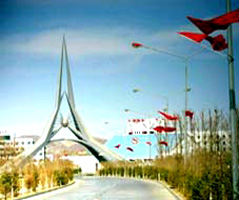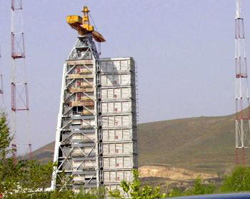 There are three major space launch bases in China: Jiuquan, Taiyuan and Xichang. All three are located in sparsely populated areas with flat terrain and broad field of vision. Founded in 1958 in Gansu Province, the Jiuquan Satellite Launch Center was the country's earliest base and where most launches and tests have been conducted. >> There are three major space launch bases in China: Jiuquan, Taiyuan and Xichang. All three are located in sparsely populated areas with flat terrain and broad field of vision. Founded in 1958 in Gansu Province, the Jiuquan Satellite Launch Center was the country's earliest base and where most launches and tests have been conducted. >> |
|
| Launch records |
| >
September 9, 2006: China launched a seed-breeding satellite, "Shijian-8", carrying 215 kilograms of seeds of plants and fungus, the largest-ever such payload since 1987.
|
| >
October 12, 2005: China launched its second manned spacecraft Shenzhou VI, sending two astronauts into orbit. It is China's first multi-manned and multi-day space flight and the first human-participated space scientific experiment program.
|
| >
August 29, 2005: China sent its 22nd return experimental satellite onto the orbit with a Long March-2IV rocket carrier. The satellite will carry out a series of jobs on scientific research, land surveying, mapping and space-technological tests.
|
| >> More |
|
 The Taiyuan Satellite Launch Center, situated in Kelan County of north China's Shanxi Province, was founded in March 1966 and came into full operation in 1968. Surrounded by mountains, Taiyuan stands at an elevation of 1,500 meters. Its dry weather makes it ideal for launching solar-synchronous satellites.
>> The Taiyuan Satellite Launch Center, situated in Kelan County of north China's Shanxi Province, was founded in March 1966 and came into full operation in 1968. Surrounded by mountains, Taiyuan stands at an elevation of 1,500 meters. Its dry weather makes it ideal for launching solar-synchronous satellites.
>> |
|
| Launch records |
| >
April 27, 2006: China successfully launched a remote sensing satellite and put it into preset orbit. The Remote Sensing Satellite No.1 blast off atop a Long March 4-B carrier rocket at 6:48 AM. The 2.7-ton satellite will be mainly used for scientific experiment, survey of land resources, appraisal of crops and disaster prevention and alleviation.
|
| >
November 6, 2004: China successfully put its earth resource satellite, the third of ZY-2, into the orbit with the Long-March 4-B rocket. The ZY-2, China's second transmitting-type remote sensing satellite, is mainly used for land resource surveying, environmental supervision and protection, city planning, crop yield assessment, disaster monitoring and space scientific experiment.
|
| >
September 9, 2004: launch of two scientific experiment satellites atop a Long March 4-B rocket carrier. With a designed life of at least two years, these satellites will be used to probe space radiation and its effects as well as other related experiments.
|
| >> More |
|
 Located in the Liangshan Yi Autonomous Prefecture of southwest China's Sichuan Province, the Xichang Satellite Launch Center is designed mainly to launch powerful thrust rockets and geostationary satellites. Known for its agreeable weather and picturesque scenes, most pictures shown on Chinese television of rockets taking off are shot here. >> Located in the Liangshan Yi Autonomous Prefecture of southwest China's Sichuan Province, the Xichang Satellite Launch Center is designed mainly to launch powerful thrust rockets and geostationary satellites. Known for its agreeable weather and picturesque scenes, most pictures shown on Chinese television of rockets taking off are shot here. >> |
|
| Launch records |
| >
September 13, 2006: China launched a new telecommunications satellite, the Zhongxing-22A, with a Long March-3A rocket carrier at 00:02 AM. The satellite has been designed to operate for eight years.
|
| >
April, 12, 2005: China sent a communication satellite -- AsiaSat-6 for Hong Kong-based APT Satellite Limited into space atop the Long March 3B rocket. The successful launch represents the return of the Chinese rockets on the international commercial launch market after an absence of seven years.
|
| >
November 18, 2004: launch of another small scientific experimental satellite. The launch aims to test some new satellite technologies, survey and monitor land, resources and the geographical environment on a trial basis.
|
| >> More |
|
|
|







